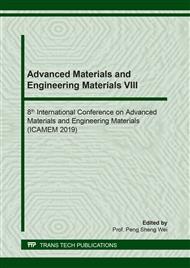[1]
P. Hangge, J. Stone, H. Albadawi, Y.S. Zhang, A. Khademhosseini, R. Oklu, Hemostasis and nanotechnology, Cardiovasc. Diagn. Ther. 7 (Suppl 3) S267-S275.
DOI: 10.21037/cdt.2017.08.07
Google Scholar
[2]
C. Shi, J. Zhao, W. Liu, Y. Feng, H. Chen, X. Yuan, Recent development and application of absorbable hemostatic materials, Polym. Bull. (5) 1-13.
Google Scholar
[3]
Z. Hu, D.Y. Zhang, S.T. Lu, P.W. Li, S.D. Li, Chitosan-based composite materials for prospective hemostatic applications, Mar. Drugs. 16 273.
DOI: 10.3390/md16080273
Google Scholar
[4]
C.H. Karen, B.A. Heidy, D.M. Gezira, A.H. Barros, A.D. Gonzalez-Delgado, Techno-economic sensitivity analysis of large scale chitosan production process from shrimp shell wastes, Chem. Eng. Trans. 70 2179-2184.
Google Scholar
[5]
M.O. Gallyamov, I.S. Chaschin, M.V. Bulat, N.P. Bakuleva, G.A. Badun, M.G. Chernysheva, O.I. Kiselyova, A.R. Khokhlov, 2018, Chitosan coatings with enhanced biostability in vivo, J. Biomed. Mater. Res. B. 106 (1) 270-277.
DOI: 10.1002/jbm.b.33852
Google Scholar
[6]
K. Sidoryk, A. Jaromin, N. Filipczak, P. Cmoch, M. Cybulski, Synthesis and antioxidant activity of caffeic acid derivatives, Molecules. 23 (9) 2199.
DOI: 10.3390/molecules23092199
Google Scholar
[7]
I.F. de Corradi, E. De Souza, D. Sande, J.A. Takahashi, Correlation between phenolic compounds contents, anti-tyrosinase and antioxidant activities of plant extracts, Chem. Eng. Trans. 64 109-114.
Google Scholar
[8]
A.O. Aytekin, S. Morimura, K. Kida, Synthesis of chitosan-caffeic acid derivatives and evaluation of their antioxidant activities, J. Biosci. Bioeng. 111 (2) 212-216.
DOI: 10.1016/j.jbiosc.2010.09.018
Google Scholar
[9]
J.H. Kim, D. Yu, S.H. Eom, S.H. Kim, J. Oh, W.K. Jung, Y.M. Kim, Synergistic antibacterial effects of chitosan-caffeic acid conjugate against antibiotic-resistantacne-related bacteria, Mar. Drugs. 15 (6) 11.
DOI: 10.3390/md15060167
Google Scholar
[10]
K.W. Zheng, W. Li, B.Q. Fu, M.F. Fu, Q.L. Ren, F. Yang, C.Q. Qin, Physical, antibacterial and antioxidant properties of chitosan films containing hardleaf oatchestnut starch and Litsea cubeba oil, Int. J. Biol. Macromol. 118 707-715.
DOI: 10.1016/j.ijbiomac.2018.06.126
Google Scholar
[11]
Y.A. Zhao, Z.J. Wang, Q. Zhang, F.X. Chen, Z.Y. Yue, T.T. Zhang, H.B. Deng, C. Huselstein, D.P. Anderson, P.R. Chang, Y.P. Li, Y. Chen, Accelerated skin wound healing by soy protein isolate-modified hydroxypropyl chitosan composite films, Int. J. Biol. Macromol. 118 1293-1302.
DOI: 10.1016/j.ijbiomac.2018.06.195
Google Scholar
[12]
M.P. Buera, K. Jouppila, Y.H. Roos, J. Chirife, Differential scanning calorimetry glass transition temperatures of white bread and mold growth in the putative glassy state, Cereal Chem. 75 (1) 64-69.
DOI: 10.1094/cchem.1998.75.1.64
Google Scholar
[13]
M. Salari, M.S. Khiabani, R.R. Mokarram, B. Ghanbarzadeh, H.S. Kafil, Development and evaluation of chitosan based active nanocomposite films containing bacterial cellulose nanocrystals and silver nanoparticles, Food Hydrocolloids. 84 414-423.
DOI: 10.1016/j.foodhyd.2018.05.037
Google Scholar
[14]
Z. Hu, P.Z. Hong, M.N. Liao, S.Z. Kong, N. Huang, C. Ou, S.D. Li, Preparation and characterization of chitosan-agarose composite films, Materials. 9 (10) 816.
DOI: 10.3390/ma9100816
Google Scholar
[15]
X. Yan, H.Y. Peng, M.X. Zhang, L. Xia, W.W. Zeng, X.E. Yang, Caffeic acid product from the highly copper-tolerant plant Elsholtzia splendens post-phytoremediation: its extraction, purification, and identification, Journal of Zheijang University SCIENCE B. 13 (6) 487-493.
DOI: 10.1631/jzus.b1100298
Google Scholar
[16]
J. Benesch, P. Tengvall, Blood protein adsorption onto chitosan, Biomaterials. 23 (12) 2561-2568.
DOI: 10.1016/s0142-9612(01)00391-x
Google Scholar


